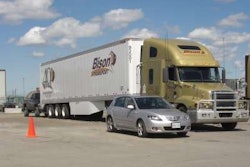 Proposed regulations covering both fuel economy and greenhouse gas emissions would affect light-duty trucks between model year 2012 and 2016.
Proposed regulations covering both fuel economy and greenhouse gas emissions would affect light-duty trucks between model year 2012 and 2016.
The Obama administration advanced its efforts to curtail greenhouse gases (GHGs) by proposing a regulation that would affect light vehicles and finalizing another that would affect heavy-duty engines. The Department of Transportation and the Environmental Protection Agency jointly proposed higher Corporate Average Fuel Economy standards for automobile and light truck manufacturers and the first-ever national emissions standards under EPA’s GHG program. The regulations affect model year 2012-2016 vehicles.
Separately, EPA issued a final rule requiring that manufacturers of heavy-duty engines and vehicles begin reporting carbon dioxide emissions from engines beginning with model year 2011. Manufacturers also will be subject to reporting of methane emissions in model year 2012 and nitrous oxide emissions in 2013. At this stage, these are just reporting requirements without a mandate to reduce emissions.
As it had proposed earlier, EPA chose not to require that fleet operators or state and local governments report in-use travel activity or other data related to greenhouse gases.
In proposing car and light-duty standards, EPA and DOT said they had crafted the proposal so that it effectively would set a single national light-duty emissions standard. In June, EPA cleared California to regulate GHG emissions at the tailpipe in automobiles and light-duty vehicles. While the EPA/DOT proposal wouldn’t preempt those standards, it is drafted so that compliance with the federal standard would meet or exceed standards that would be set by states.
The proposed rules would increase average fuel economy by about 5 percent each year during the 2012-2016 period and would require that model year 2016 vehicles meet an estimated combined average emissions level of 250 grams of carbon dioxide per mile. Cars and light trucks could meet the carbon standard solely through increased fuel economy, though there would be other options for meeting the standard.
DOT and EPA estimate that under the plan, the overall light-duty vehicle fleet would reach 35.5 mpg in model year 2016 – provided that manufacturers chose to achieve carbon dioxide emissions standards solely through fuel economy improvements. This would achieve the fuel economy standard mandated by Congress four years ahead of schedule.










